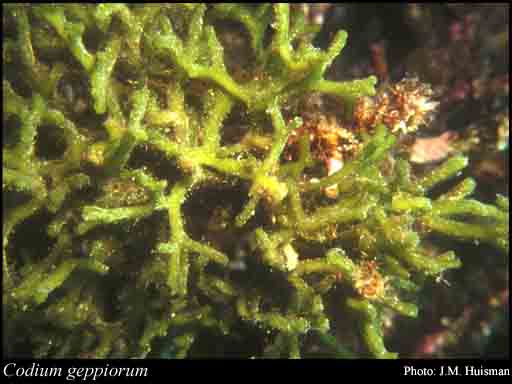- Reference
- Biblioth.Bot. 23(91):50, Fig. 33 (1923)
- Conservation Code
- Not threatened
- Naturalised Status
- Native to Western Australia
- Name Status
- Current

Scientific Description
Habit and structure. Thallus procumbent, repent, densely branched, forming patches to 8 cm diam., attached to the substratum here and there by small tufts of rhizoids. Branches subterete, narrow, 2–4 mm wide, divaricate, intertwining. Utricles produced individually by enlargement of interutricular filaments, obovate to clavate or subpyriform, tapering basally to a greater or lesser extent, 470–790 μm long, 95–250 μm diam. Hairs (or hair scars) infrequent. Gametangia conical to fusiform, 80–180 μm long, 40–65 μm diam., borne near the midline of the utricle. Medullary filaments mostly 15–30 μm diam.
Distribution. Widespread in the Indo-Pacific.
Habitat. Epilithic in the intertidal and subtidal.
[After Silva & Chacana, Algae of Australia: Mar. Benthic Algae of North-western Australia, 1. Green and Brown Algae 109 (2015)]
Distribution
- IBRA Regions
- Dampierland, Indian Tropical Islands, Pilbara.
- IBRA Subregions
- Pindanland, Roebourne.
- IMCRA Regions
- Kimberley, Pilbara (nearshore), Pilbara (offshore).
- Local Government Areas (LGAs)
- Ashburton, Broome, Cocos Islands, Karratha, Wyndham-East Kimberley.